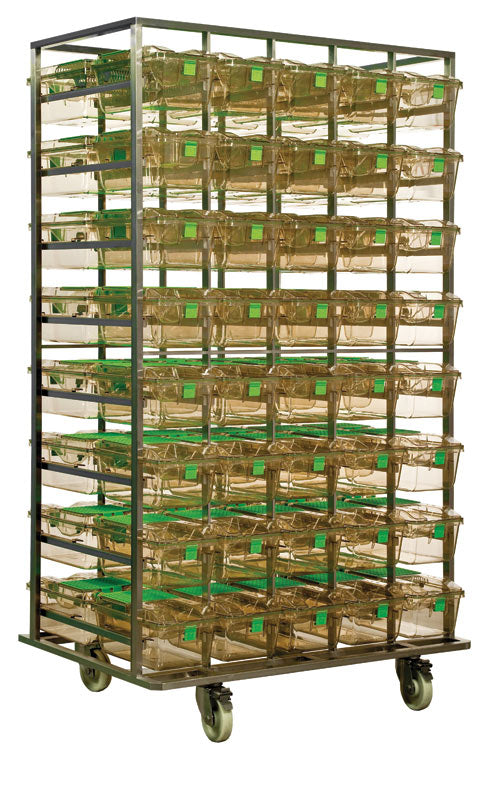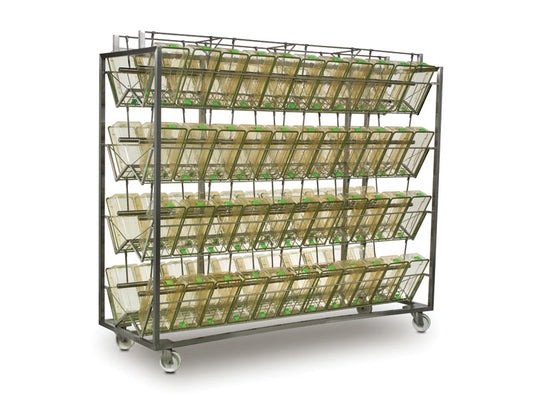The Next Evolution in Vivarium Management
Laboratory animal science is at an inflection point. Just as artificial intelligence is transforming the workplace through data, automation, and connected systems, technology stacking is transforming the vivarium—quietly reshaping how we care for animals, manage operations, and design the next generation of facilities.
Traditionally, innovation in vivaria has focused on individual improvements: better cages, more efficient washers, or upgraded air-handling systems. Each was valuable, but incremental.
Today, the leading facilities are connecting those elements into integrated systems that share information, allowing animal welfare data to inform husbandry, scheduling, and even facility design.
This convergence is creating vivaria that are not only more efficient—but more humane, sustainable, and resilient [1].
Smart Cages and the Power of Continuous Insight
The foundation of this shift lies in continuous cage-level monitoring. Platforms such as Tecniplast’s DVC® collect activity and environmental data 24 hours a day, providing a continuous picture of animal well-being and cage conditions [2].
This changes everything. Instead of relying on a fixed schedule or subjective assessment, husbandry teams can now act on objective, real-time data.
Early indicators of environmental degradation, circadian disruption, or abnormal activity patterns can trigger timely interventions before they affect welfare or study outcomes.
For the first time, the vivarium can operate as a responsive ecosystem—adjusting care based on data, not assumptions.
From Calendar to Condition-Based Care
In many facilities, cage changes still follow a calendar. But we know every animal population behaves differently. Strain, sex, breeding status, and bedding type all influence how quickly a cage environment changes [3].
Smart monitoring allows a shift toward condition-based husbandry: changing cages only when needed, based on validated performance indicators such as ammonia levels, humidity, or behavioral data.
The results have been consistent and compelling:
- 40–60% reduction in cage-change frequency in validated pilot programs [4].
- Improved animal welfare, with fewer disturbances and more stable behavioral baselines.
- Lower consumption of PPE due to reduced handling.
- Improved biosecurity, because fewer cage movements mean fewer cross-room transfers and contamination opportunities.
- Better ergonomics and job satisfaction, as repetitive, high-exertion tasks give way to data review and welfare observation.
Each of these gains compounds, creating a healthier workplace and a calmer, more consistent environment for animals.
The Ripple Effect: From Washing to Water, Energy, and Automation
Once cage changes decrease, the cascade of benefits extends throughout the facility.
Fewer cages through the wash area means fewer cycles, reduced use of water and detergent, and lower energy consumption [5]. It can even allow facilities to reduce the size of their washing area altogether, saving valuable floor space and capital cost.
EPA WaterSense reports that vivarium cage and rack washers are among the most water-intensive equipment in research facilities [6].
Condition-based schedules directly reduce:
- Washer cycles
- Hot water and steam demand
- Heat and humidity output, which further lowers reheat and dehumidification loads
For facilities with sustainability goals, these reductions translate to measurable progress in energy and water conservation reporting.
It’s also a significant improvement in the workplace environment.
Fewer heavy carts to push, fewer dirty cages to handle, and shorter exposure times to hot, humid conditions mean fewer repetitive stress injuries, less fatigue, and higher morale among animal care technicians [7].
Robotics and Automated Handling: The New Layer of the Stack
As digital monitoring and condition-based care reshape the workflow, another transformation is happening on the logistical side of vivarium operations: automation in material handling.
Automated Guided Vehicles (AGVs), Autonomous Mobile Robots (AMRs), and articulating robotic arms are now integrated into cage-handling systems for both the clean and dirty sides of operations [8].
These technologies automate transport, sorting, and stacking, enabling:
- Reduced manual lifting and repetitive strain for staff.
- Tighter biosecurity control, since robots follow fixed, validated routes between clean and dirty areas.
- Continuous operation, allowing facilities to run partial or offset shifts for washing and cage preparation.
- Data integration, connecting logistics to the same digital backbone as monitoring and husbandry.
Fully automated systems like these redefine how a vivarium runs—not just in efficiency, but in rhythm. With robotics managing repetitive logistics, technicians and veterinarians can dedicate more time to direct animal care, data interpretation, and welfare oversight.
However, automation should not be adopted for its own sake. The goal is to select the ideal robot for each task, not simply “add a robot.” The most successful facilities design their automation stack around workflow needs—choosing between AGVs, articulated robots, or conveyors based on space, throughput, and biosecurity requirements [9].
Right-Sizing Infrastructure for New Facilities
While monitoring data can’t change the ventilation rate of an existing building, it can inform smarter design for future ones.
In new vivarium construction, performance-based environmental monitoring has allowed design teams to justify reduced air-change rates (ACH) while maintaining or exceeding welfare standards [10].
This is not about cutting corners—it’s about aligning airflow to real, validated conditions.
Architects and engineers have demonstrated that these performance-based designs can achieve:
- Smaller HVAC systems
- Lower mechanical loads
- Reduced capital and operating costs
Technology stacking, including automation and monitoring, is not just improving daily operations—it’s shaping the way we build the vivarium of the future.
Beyond Technology: A Shift in Professional Practice
Perhaps the most important change is philosophical.
The move toward connected systems represents a maturation of the field—from manual routines to evidence-based management that empowers the people closest to the animals.
Technicians and veterinarians can now interpret live data, refine SOPs, and make adjustments based on actual cage conditions. The result is a stronger link between welfare, operations, and scientific outcomes.
Automation doesn’t replace the expertise of animal care professionals; it elevates it. By removing repetitive, low-value tasks, it gives teams more time for observation, preventive health, enrichment, and the nuanced decisions that define excellence in laboratory animal care [11].
Demonstrated Outcomes Across Facilities
Recent studies and case reports highlight the tangible impact of this integrated approach:
- A U.S. research center using DVC® extended cage-change intervals from two weeks to up to five weeks, reducing cage handling by 65% while maintaining ammonia levels below thresholds [12].
- A European facility redesigning its cage-wash area based on actual load data reduced energy use by 45% and water consumption by 38% [13].
- Animal care teams reported measurable decreases in musculoskeletal strain and improved job satisfaction after reducing manual cage-handling tasks [14].
- New vivarium designs using validated environmental data have achieved air-side energy savings of up to 60%, with corresponding reductions in mechanical system size and construction cost [15].
The Broader Context: The Data-Driven Vivarium
Just as AI has changed the way industries make decisions, digital integration is redefining how vivaria operate.
Instead of static procedures, the modern facility learns from its own data—iterating toward greater welfare, safety, and efficiency over time.
The benefits are multidimensional:
- Animal welfare: fewer disturbances, more stable environments.
- Human welfare: improved ergonomics, safety, and engagement.
- Operational efficiency: reduced labor intensity and utility costs.
- Sustainability: measurable reductions in water, energy, and materials.
- Biosecurity: fewer opportunities for cross-contamination through unnecessary cage handling.
This is not a theoretical model—it is a proven operational framework being implemented in leading research institutions around the world [16].
References
[1] Tradeline (2024): Digital Vivarium Automation and Facility Optimization.
[2] Tecniplast DVC® Technical Overview (2024).
[3] Nature Lab Animal (2023): Condition-Based Husbandry and Extended Cage Intervals.
[4] AAALAC International (2023): Performance-Based Standards in Laboratory Animal Care.
[5] EPA WaterSense (2022): Water Efficiency in Vivarium Operations.
[6] EPA WaterSense (2022): ibid.
[7] Lab Animal (2023): Occupational Ergonomics and Cage Handling.
[8] Tecniplast VOYAGER AGV Overview (2024).
[9] IWT COSMOS Robotic Handling System (2023).
[10] Perkins & Will (2024): Smart Monitoring and Demand-Based Ventilation in Research Facilities.
[11] AAALAC International (2023): ibid.
[12] Nature Lab Animal (2023): ibid.
[13] European Research Facility Case Report (2024).
[14] Tradeline (2024): ibid.
[15] Perkins & Will (2024): ibid.
[16] Multiple case studies, 2023–2024: Integrated automation and data monitoring in vivarium operations.








